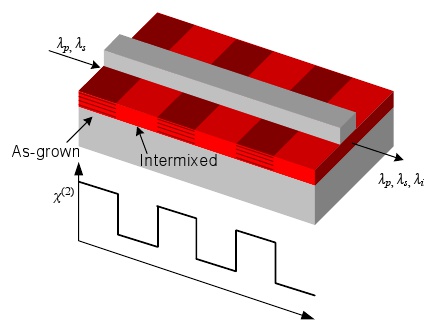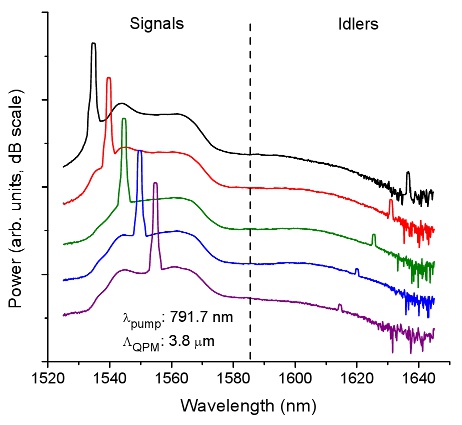Optical Frequency Conversion in Semiconductor Waveguides
This research project addresses an emerging demand for low-cost, room-temperature, compact and flexible optical sources in the near- and mid-infrared part of the spectrum due particularly to an increasing need for sensing applications, e.g. environmental, clinical analysis, life sciences, food monitoring, pharmaceutical, security and forensics.
III-V semiconductors possess very large second-order nonlinear optical coefficients and a maturing fabrication technology base for optoelectronic components and integration. The limiting factor in their exploitation in optical frequency generation and conversion applications is the lack of birefringent phase-matching in cubic crystals. Consequently, there is considerable interest in quasi-phase-matching techniques in micro-structured devices. We have developed a novel technique where the nonlinear optical coefficient is spatially modulated with micron-scale resolution using ion-implantation induced quantum well intermixing in a GaAs/AlGaAs superlattice waveguide. This post-growth technique is compatible with the fabrication of semiconductor diode lasers and other guided-wave components in the same structure.

We have demonstrated both type-I (TE to TM) and type-II (TE and TM to TE) Second Harmonic Generation, both with picosecond pulsed and continuous-wave fundamental injection. We have also demonstrated continuous-wave difference frequency generation.

In order to demonstrate the monolithic integration compatibility with laser pump sources, a similar GaAs/AlGaAs superlattice waveguide core was incorporated within a p-i-n diode laser wafer structure grown by MOVPE. Lasing has been demonstrated at a wavelength of 801 nm. We have also developed dichroic couplers based on Multi-Mode Interference waveguide couplers. These would allow pump and signal wavelengths to be injected into a common converter waveguide and facilitates intra-cavity wavelength conversion formats.
Therefore we have demonstrated the individual components necessary to realise the monolithic integration of laser pump sources with frequency conversion elements, such as difference frequency generation for WDM channel shifting, or optical parametric generation of new near- and mid-IR wavelengths for sensing applications.
DD-QPM Invited Presentation from Photonics North 2010.
People
- Prof. David C. Hutchings
- Dr. Barry M. Holmes
- Dr. Usman Younis
This research has been undertaken in collaboration with Prof. Stewart Aitchison, Prof. Amr Saher Helmy and Dr. Sean Wagner, University of Toronto. The contributions of the EPSRC National Facilities are acknowledged: III-V Technologies, University of Sheffield and University of Surrey Ion Beam Centre.
Publications
- P. Sarrafi, E.Y. Zhu, K. Dolgaleva, B.M. Holmes, D.C. Hutchings, J.S. Aitchison, and Li Qian (2013) Continuous-wave quasi-phase-matched waveguide correlated photon pair source on a III-V chip, Applied Physics Letters 103, 251115 DOI: 10.1063/1.4851095.
- Wagner, S.J., Holmes, B.M., Younis, U., Sigal, I., Helmy, A.S., Aitchison, J.S. and Hutchings, D.C. (2010) Difference frequency generation by quasi-phase matching in periodically intermixed semiconductor superlattice waveguides, IEEE J. Quantum Electron. 47 (6), pp. 834-840 DOI: 10.1109/JQE.2011.2126562
- Hutchings, D.C., Wagner, S.J., Holmes, B.M., Younis, U., Helmy, A.S. and Aitchison, J.S. (2010) Type-II quasi phase matching in periodically intermixed semiconductor superlattice waveguides. Optics Letters, 35 (8). pp. 1299-1301.
- Younis, U., Holmes, B.M., Hutchings, D.C. and Roberts, J.S. (2010) Towards Monolithic Integration of Nonlinear Optical Frequency Conversion. IEEE Photonics Technology Letters, 22 (18). pp. 1358-1360.
- Wagner, S.J., Holmes, B.M., Younis, U., Helmy, A.S., Aitchison, J.S. and Hutchings, D.C. (2009) Continuous wave second-harmonic generation using domain-disordered quasi-phase matching waveguides. Applied Physics Letters, 94 (15).
Theses
- Younis, Usman (2010) Monolithic integration for nonlinear optical frequency conversion in semiconductor waveguides. PhD thesis
- Wagner, Sean J. (University of Toronto, 2011) Wavelength Conversion in Domain-Disordered Quasi-Phase Matching Superlattice Waveguides. PhD thesis

